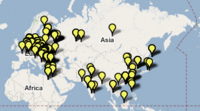
Five years of the Anti-Phishing Working Group! Dave Jevans gave a retrospective, followed by country reports:
Japan: Pretending to be grandchild to get bank account transfer is popular. ATM
scams are the most lucrative.
Russia: Second biggest global source of spam. Ecrime economy is ten times the si
ze of the anti-ecrime industry, and that’s a problem.
Brazil: Most phishing is done locally. Is all organized crime.
I don’t want to go into too much detail, even though the bad guys don’t seem to
need any help. APWG continues to climb the ecrimeware curve, catching up with th
e miscreants.
 Gunnar Peterson
asks a question:
Gunnar Peterson
asks a question:


